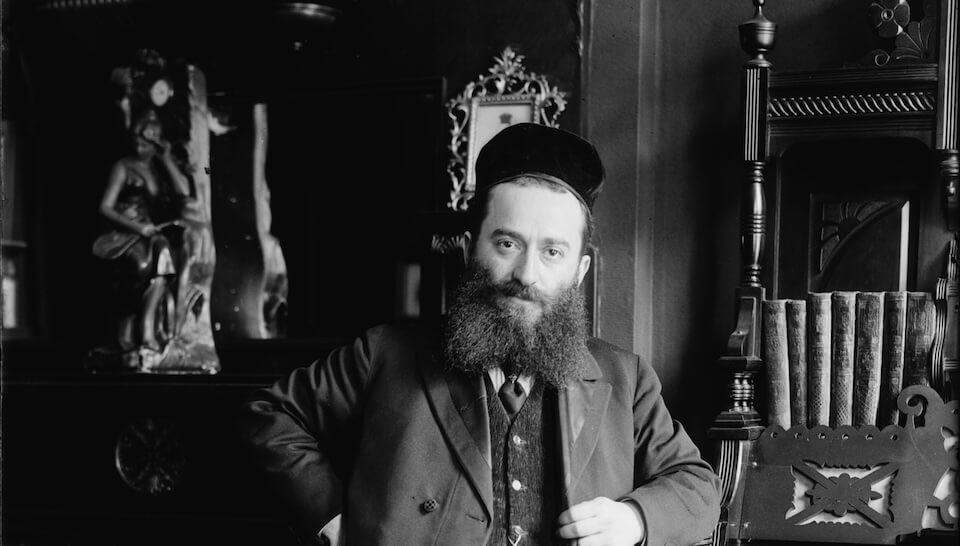Reimagining the Lively Character of Pre-War Smocza Street

Image by Photo from the Archive of the Emanuel Ringelblum Jewish Historical Institute in Warsaw, Poland
This article originally appeared in the Yiddish Forverts.
For the past few months I’ve been living in a place that no longer exists.
I may be sleeping in my own bed in Tel Aviv, but every morning, at the light of dawn, I steal across the borders of time to a thriving Jewish street in Warsaw as it appeared between the two world wars: Smocza (pronounced, in Yiddish: Smotshe) Street.
You can still find a street with that name in Warsaw today, in nearly the same spot, in Muranów (pronounced Muranov) between the new Polin Museum of the History of the Jews in Poland, and the old cemetery on Okopowa (Okopova) Street. Yet, there isn’t a single stone marking that era, let alone a plaque memorializing the murdered Jewish residents.
Every morning, even before I receive the day’s newspaper, I dive into newspapers of that period that I find on the internet – Haynt, Moment, Undzer Ekspres, Literarishe Verk, etc – to see “what’s happening” on Smocza Street. By now I’ve found hundreds, if not thousands, of news items. I pore over books, both stories and memoirs of Warsaw, hoping to find something, anything of Smocza Street inside.
Why Smocza Street? There were certainly more beautiful and important spots in Jewish Warsaw, like Nalevke (Nalewki). There were more famous ones, like Krokhmalne Street, described in detail by Isaac Bashevis Singer in his autobiographical novel, “In My Father’s Court,” or Dzike Street from Kadya Molodowsky’s children’s poems. Smocza Street has no such claim. In fact, it was known as a street of deep poverty.
I first heard the name Smocza Street many years ago, in Binem Heller’s poem, “My Sister Khaye,” which Chava Alberstein put to music and recorded with the Klezmatics. Heller writes about his own sister: “With those green eyes / that raised me on Smocze Street / in the house with crooked stairs.” He describes Khaye, who took care of all her brothers, and what eventually became of her: “A German burned her in Treblinka. / And I am here in the Jewish state / the last one left who knew her.”
This sister Khaye and Smocza Street were etched in my memory for years, and waited patiently until one day, as I was walking through Anielewicz Street in Warsaw (known as Genshe Street before the war), I beheld a street sign with the word Smocza. I looked all around and saw nothing but contemporary buildings, with no hint of the pre-war homes. No surprise there; Smocza was a part of the old Warsaw ghetto, and was destroyed together with all the other streets in the uprising. In the 1950s and ’60s, the street was rebuilt, and now has no trace of its history. I have a hunch that the new Smocza was an attempt by Poles to erase the bad memories – not only of the Holocaust, but of the street itself.
In prewar Poland, Smocza was an unwelcome place, a blighted eyesore to the city. In a book called “The Unsavory Neighborhoods of Pre-war Poland,” the author writes: “Most of Warsaw’s inhabitants knew Smocza only from police reports. The street was ugly and dangerous.” Smocza was frequently in sections of Polish newspapers reporting on criminal cases, accidents, epidemics and hunger in the streets.
Smocza, like other Jewish quarters, was often described in these Polish sources as an unfamiliar labyrinth; they were reluctant to enter the neighborhood and see it up close. Even Jews visiting the city were affected by stereotypes about the street and described it back home in clichés. The writer Leyb Malekh, for example, visited Warsaw and wrote this about Smocza in his book, “From Poland to Turkey”:
“The darkness in those streets is so thick, that even when the sun shines, casting seas of light, it is dark, depressing and neglected… The people look like they had just stepped out of trash cans.”
Moyshe Zonsheyn, a Warsaw journalist, wrote in his book “Yiddish Warsaw”: “There was a time, when ‘better’ people avoided the street entirely and refused to live there. This wasn’t the street’s fault. It suffered this fate because of several side-streets… Smocza Street was low-class.”
When describing a typical resident of Smocza in his short story “In the Rich Streets,” the Yiddish writer Avrom Reyzen writes: “He is, of course, a shoemaker, and lives in a basement.” In his story “The Kopek.” B. Yeushzon (Moyshe Bunem Yustman) writes about a tutor who teaches in an attic.
A basement, an attic, a shoemaker, and a tutor … all little more than stereotypes which don’t allow us to see the full picture. As I did my research, I found, surprisingly, that aside from tutors and shoemakers, the street also had pharmacists, physicians, teachers, storeowners, and people of all trades.
There was also quite a bit written about a new kind of Jewish resident: those of the Jewish working class, as described by the poet, Y.L. Cohen, who may have lived on Smocza Street himself: “Hardship drove me to the streets, to the train stations, / I carried people’s suitcases and bags for pennies, / Sold newspapers, bagels, irises – / just like a street urchin.” Cohen eventually became a Bundist and found hope for the impoverished workers: “I found happiness among a group of guys / in the fire of work and in the fight of the proletariat.” And so, it became “easier to carry the burden, because I know / that I am not alone.”
When you read the news and announcements, it’s staggering to see the warmth and vitality of the street, despite its negative image. There was a lively bazaar in Smocza 28, and across the way stood a theater named the Eldorado. The family dynasties in the Yiddish theater, the Kaminskis and the Turkovs, may have looked down on the overly sentimental productions staged at the Eldorado, but others, like Moyshe Zonsheyn, understood its importance:
“There was no other theater in Warsaw like the one on Smocza where the public could live vicariously through the characters on stage… The Jewish residents of Smocza went there to escape their own impoverished lives, to cry over someone else’s misfortune, and share in someone else’s happiness.”
Indeed, melodramas like “The Gypsies,” “That Lively Woman” and many others were performed there. Artists like Rose Shoshana, Morris Lempe, Khane Grosberg, and Ben-Zion Witler played, danced, and sang there. But Eldorado was an active theater for only a few years, and then became a cinema called Metro, which played a variety of films in Yiddish and in other languages, until the last days of August 1939, when the Jews were rounded up.
There was also a Hebrew school (Smocza 8) and a synagogue (Smocza 22), famous for holding the very last minyan on Shabbos morning, “when all other shuls had long since finished their services… the last minyan started at 10:30,” writes Benjamin Davidson in his book of memoirs about Warsaw, published in Israel in 1971.
Luckily, most of the stories in these newspapers give us details of the residents themselves, like Leyb Rudnitsky, a young man from Smocza 8, whose sweetheart left him, throwing him into such despair he tried to kill himself in front of her house. This was reported in the Yiddish daily “Undzer Ekspres,” which adds that he was, thankfully, saved by several good Samaritans. The newspaper doesn’t report anything else about Rudnitsky, but his name appears, unfortunately, among the six million names of the murdered Jews in Yad Vashem, and just several details: he became a businessman, married a woman named Rushka and died in the Warsaw ghetto.
Many names of survivors from among the “Smoczers” can be found in the testimonies of Yad Vashem. Nechama Kurisky, who was a child on Smocza Street, now lives in Natzrat Ilit (Upper Nazereth) in Israel. She was born in 1930, and her childhood memories are precious as gold to me.
“We, my parents and the three children, may not have been rich but we weren’t very poor either,” Nechama told me. The Appelbaums lived in a small house on Smocza 1, and Nechama (then known as Nikhe) loved to go to the Metro and check the movie schedule at the local kiosk to know when they were showing “Flip and Flop” (Laurel and Hardy’s moniker in Polish).
Nikhe-Nechama is one of the tens of thousands of people who lived in the 60 houses of Smocza Street. Every house actually consisted of three houses set around a courtyard. On average, a thousand people (93 percent of them Jewish), lived in those homes. As Moshe Grossman wrote in his book, “Confessions of a Revolutionary”: “In one such narrow yard you could find as many people living there as you’d find in an entire village.”
Smocza was, in fact, a microcosm of Jewish life in pre-war Warsaw, and for me it’s been a deeply inspiring way to meet the people who lived in the language in which I write today. My goal: to write a book about the street, to recreate a Smocza in words.
If you yourself know something about Smocza Street, please write to me at [email protected].





















